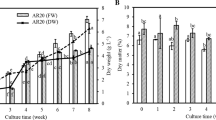Abstract
Ginseng (Panax ginseng C.A. Meyer) hairy root cultures, which are established via the infection of ginseng root discs withRhizobium rhizogenes, have been used to construct profiles of both biomass growth and nutrient consumption in flask cultures. In a 250 mL shake flask culture, the maximum biomass was observed on the 59th day of the culture period, at 216.8 g (fresh wt) per liter or 11.4 g (dry wt) per liter. The hairy roots were determined to have a growth rate of 0.355 g-DW/g cells/day during the exponential growth phase and a maximum specific growth rate on day 7. Total ginseng saponin and phenolic compound contents were noted to have increased within the latter portion of the culture period. Linear correlations between increases in biomass weight and nutrient uptake were used to imply the conductivity yield 2.60 g-DW/(L·mS) and carbon yield 0.45 g-DW/(g sugar) in the 250 mL flask cultures. The biomass yield when two different nitrogen sources were used (ammonia and nitrate) was shown to remain approximately constant, at 0.47 g-DW/(l·mM NH4) and 0.33 g-DW/(L·mM NO3); it remained at these levels for 16 days with the ammonia, and for 24 days with the nitrate. The biomass yield when a phosphate source was used was also shown to remain approximately constant for 9 days, at 3.17 g-DW/(L·mM PO4), with an R2 of 0.99.
Similar content being viewed by others
References
Verpoorte, R., R. van der Heijden, H. J. G. ten Hoopen, and J. Memelink (1999) Metabolic engineering of plant secondary metabolite pathways for the production of fine chemicals.Biotechnol. Lett. 21: 467–479.
Lee, J. H., N. H. Loc, T. H. Kwon, and M. S. Yang (2004) Partitioning of recombinant human granulocytemacrophage colony stimulating factor (hGM-CSF) from plant cell suspension culture in PEG/sodium phosphate aqueous two-phase systems.Biotechnol. Bioprocess Eng. 9: 12–16.
Alfermann, A. W. and M. Petersen (1995) Natural product formation by plant cell biotechnology.Plant Cell Tissue Organ cult. 43: 199–205.
Ramachandra, R. S. and G. A. Ravishankar (2002) Plant cell cultures: Chemical factories of secondary metabolites.Biotechnol. Adv. 20: 101–153.
Verpoorte, R. and A. W. Alfermann (2000)Metabolic Engineering of Plant Secondary Metabolism. Kluwer Academic Publishers, London, UK.
Canto-Canche, B. and V. M. Loyola-Vargas (1999) Chemicals from roots, hairy roots, and their application. pp. 235–275. In: F. Shahidi, P. Kolodziejczyk, J. R. Whitaker, A. L. Munguia, and G. Fuller (eds.).Chemicals via Higher Plant Bioengineering (Advances in Experimental Medicine and Biology, 464). Kluwer Academic Publishers. New York, NY, USA.
Giria, A. and M. L. Narasu (2000) Transgenic hairy roots: recent trends and applications.Biotechnol. Adv. 18: 1–22.
Furuya, T., H. Kojima, K. Syono, and M. Nishio (1973) Isolation of saponins and sapogenins from callus cultures ofPanax ginseng.Planta Med. 47: 183–187.
Jeong, G. T. and D. H. Park (2005) Enhancement of growth and secondary metabolite biosynthesis: Effect of elicitors derived from plants and insects,Biotechnol. Bioprocess Eng. 10: 73–77.
Wu, J. and J. J. Zhong (1999) Production of ginseng and its bioactive compounds in plant cell culture: Current technological and applied aspects.J. Biotechnol. 68: 89–99.
Fuzzati, N., B. Gabetta, K. Jayakar, R. Pace, and F. Peterlongo (1999) Liquid chromatography-electrospray mass spectrometric identification of ginsenosides inPanax ginseng roots.J. Chromatogr. A 854: 69–79.
Jung, M. Y., B. S. Jeon, and J. Y. Bock (2002) Free, esterified, and insoluble-bound phenolic acids in white and red Korean ginsengs (Panax ginseng C.A. Meyer).Food Chem. 79: 105–111.
Jeong, G. T. (2004)Optimization of Useful Metabolites Production System Using Transformed Hairy Roots of Panax ginsengC.A. Meyer. Ph.D. Thesis. Chonnam National University, Gwangju, Korea.
Kwok, K. H. and O. M. Doran (1995) Kinetic and stoichiometric analysis of hairy roots in a segmented bubble column reactor.Biotechnol. Prog. 11: 429–435.
Dougall, D. K. (1980) Nutrition and metabolism. pp. 21–58. In: E. J. Staba (eds.).Plant Tissue Cultures as a Source of Biochemicals. Chemical Huibber Company Press, Boca Raton, FL, USA.
Uozumi, N. and T. Kobayashi (1994) Application of hairy root and bioreactors, pp. 307–338. In: Ryu, D. D. Y. and S. Furusaki (eds.).Advances in Plant Biotechnology. Elsevier, New York, NY, USA.
Rho, D. and G. Andre (1991) Growth and stiochiometry of aCatharanthus roseus cell suspension culture growth under nitrogen-limiting conditions.Biotechnol. Bioprocess Eng. 38: 579–587.
Taya, M., A. Yoyama, R. Nomura, O. Kondo, C. Matsui, and T. Kobayashi (1989) Production of peroxidase with horseradish hairy root cells in a two step culture system.J. Ferment. Bioeng. 67: 31–34.
Ballica, R., D. D. Y. Ryu, and C. L. Kado (2001) Tropane alkaloid production inDatura stramonium suspension cultures: Elicitor and precursor effects.Biotechnol. Bioeng. 41: 1075–81.
Author information
Authors and Affiliations
Corresponding author
Rights and permissions
About this article
Cite this article
Jeong, GT., Park, DH. Characteristics of transformedPanax ginseng C.A. Meyer hairy roots: Growth and nutrient profile. Biotechnol. Bioprocess Eng. 11, 43–47 (2006). https://doi.org/10.1007/BF02931867
Received:
Accepted:
Issue Date:
DOI: https://doi.org/10.1007/BF02931867




